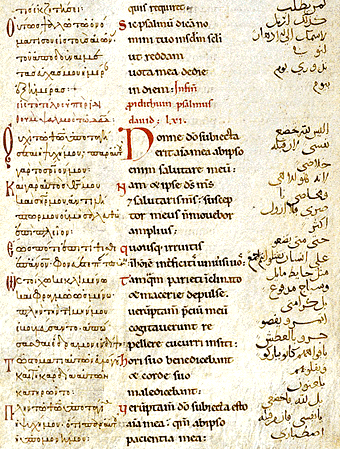...Best of Sicily presents... Best of Sicily Magazine. ... Dedicated to Sicilian art, culture, history, people, places and all things Sicilian. |
by Daniela Paglia | ||
Magazine Index Best of Sicily Arts & Culture Fashion Food & Wine History & Society About Us Travel Faqs Contact Map of Sicily |
One of the more instructive works, of those few which survive today (for there were once many such works), is the prayer book called the "Harley Trilingual Psalter"(catalogued as Harley 5786), a parchment "codex" inscribed during the reign of Roger II (probably around 1140) in Latin, Greek and Arabic, and now retained in the collection of the British Library. (Most recently, it was displayed as part of the exhibit Sacred at the British Library.) Various theories have been advanced to explain the composition of the psalter; the psalms are of particular interest. As a Biblical work, many of its Arabic translations were probably intended for Muslims converting to Christianity. The Latin texts were probably intended, at least in part, for the benefit of Orthodox Christians as the Church became more and more westernised. With over 170 parchment pages measuring 31 by 22 centimetres, it is a fairly large volume. By the 1720s it was in the possession of Robert Harley, first earl of Oxford and Mortimer. One of his descendants sold it to the English government in 1753. The Greek text is based on the Septuagint, the Greek version of the Hebrew scriptures. The Arabic translation of the Psalms was executed by an (Orthodox) monk of the Antiochian Church. The Latin text, which is typically western, is a "Gallican" version of Saint Jerome's erudite, early fifth-century "Vulgate." The Harley Psalter is essentially a liturgical work. Unlike the poetry of Ciullo of Alcamo, it does not contain, nor shed much light upon, the vernacular Sicilian language of the twelfth century. However, it should be remembered that most medieval religious texts were not written (copied) in contemporary language --though the Koran's Arabic would have been readily comprehensible to Arab readers of the Psalter. It has been suggested that this Psalter was used by a particularly important, multiethnic congregation, perhaps members of the royal court. Whoever used it, its message endures. . About the Author: Freelance journalist Daniela Paglia formerly taught history and Italian studies in a high school in Catania. | |
Top of Page |
 For all its multicultural influences, the Sicily one sees today is essentially
Latin and (despite increasing choices in matters of faith) Roman Catholic.
It has been so since the fourteenth century. By 1300 very few Byzantine
(Orthodox) monasteries remained, mostly in the
For all its multicultural influences, the Sicily one sees today is essentially
Latin and (despite increasing choices in matters of faith) Roman Catholic.
It has been so since the fourteenth century. By 1300 very few Byzantine
(Orthodox) monasteries remained, mostly in the